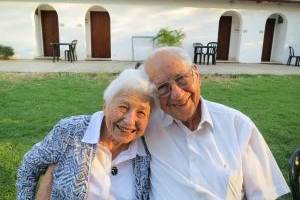
Coronavirus, COVID-19, has descended upon us with innumerable challenges. Not least among the myriad, is the inability to say Kaddish with a minyan. There has been lively discussion about this topic and I would like to add my experience as a mourner who found herself without a minyan in Kathmandu, Nepal, during the year I was saying Kaddish for my mother in the hope that those of you who are saying Kaddish for a loved one will find some comfort in these words. For the rest of you dear readers you can view this is a journey into finding creativity within our rich traditions.
The story begins with my fourth and final trip to Nepal in early September of 2016. I welcomed the opportunity to complete a project I had directed for Tevel B’tzedek in the aftermath of the 2015 earthquake, yet I had misgivings about giving up Kaddish for a full two weeks. Up until this point I had managed Kaddish with a minyan every single day since my mother’s passing in May. When agreeing to the trip I knew it meant that I would not have a daily minyan for the duration. There was a slim possibility of saying Kaddish with a minyan on Shabbat at the famous Chabad of Kathmandu, but even that was uncertain, as this was the off-season for tourists, and trekkers were rare.
After weighing the pros and cons, I decided in favor of the trip to Nepal, realizing that so often in life we have to compromise. I was at peace with my decision. Yes, I would miss my daily minyan, and the opportunity to say Kaddish, as well as the few moments I shared with my mother each day. Yet, I was quite certain that if I were able to talk it over with my mother she would have encouraged me to go. The last thing she ever wanted to do was to stand in the way of me doing my work, even if it was in Nepal, and even if it meant missing Kaddish. Of this, I was certain.
In considering how to fill the gap created by the Kaddishes I would be missing, I called upon the custom of learning a mishna in memory of the departed when one is unable to fulfill the obligation of saying Kaddish. Since I was already studying a small piece of mishna every morning in the synagogue, it was easy to continue this practice in Nepal, with a small twist. I made sure to dedicate the learning to my mother, adding the special prayer before learning the mishna that is included at the end of most volumes of mishna. The addition of this prayer allowed me a few precious moments in my busy day to be with her. The problem was, mishna was something that I was already doing back in Israel. What else could I do? How else could I make a place for my grief during this intense work trip to Nepal? Kaddish Yachid might just be the answer.
A few weeks prior to my trip, as I was contemplating the impact of missing Kaddish, and fishing around the internet for some glimmer of a solution, I encountered the Kaddish Yachid, the Individual’s Kaddish, attributed to Rav Amram Gaon from the ninth century. This Kaddish is recited when an individual does not have a prayer quorum available that he or she can participate in. Rav Amram Gaon, also known as Amram ben Sheshna, who lived in Babylonia and was the head of the great Talmudic Academy of Sura, wrote it. He wrote over 120 responsa but is best known for his Siddur, his prayer book, which contains the order of Jewish prayers and blessing for the entire cycle of the year. Recalling that the prayer service we have today did not exist during the times of the Temple and the immediate aftermath, Rav Amram Gaon’s siddur, often considered the original prayer book, has formed the basis of prayer service in both Ashkenazi and Sefardi prayer traditions. Thus, the Individual Kaddish, or Kaddish Yachid, while not very well known today, seems to have a substantial foothold in Jewish tradition. Interestingly, the first mention of the regular Kaddish that we use on a daily basis also makes its appearance in Rav Amram Gaon’s siddur.
Considering the Individual Kaddish, I began to think about the many small villages and communities scattered throughout the Diaspora where Jews lived and where, undoubtedly, a prayer quorum was hard to come by on a daily basis. We all grew up on stories of our Jewish ancestors who would travel long and far to spend the High Holidays and Jewish festival among co-religionists. These isolated Jews would certainly have wanted to memorialize their loved ones and mark their passing in some fashion. The Individual Kaddish of Rav Amram Gaon, could provide some succor. To my mind, there is no doubt that a major point of the obligation to say Kaddish with a minyan is in order to make sure that the mourner remains a part of the community, and does not feel all alone in his or her mourning. To have the loss acknowledged by neighbors and friends, or fellow Jews, and to feel supported and connected to other people is a major benefit of saying Mourner’s Kaddish, even though the mourner may be oblivious to this, certainly in the early days of mourning.
None of these benefits would accrue to a person who chose to say the Individual Kaddish when a prayer quorum could not assemble or be found. Yet, doing something in the face of death, even if that something is done alone, can be very healing. What is that “something”? It can be performing an action that is unique, different, and especially dedicated to the person one has lost. This can help the mourning process. To that end, saying the Individual Kaddish, even in the privacy of one’s hotel room, might afford me the opportunity that I was looking for on my solo trip to Nepal.
Before setting out, I decided that for the duration of my trip to Nepal I would recite the Individual Kaddish with my morning prayers. I was curious what it would feel like. Would it be in any way similar to the experience of saying Kaddish in the synagogue? I wondered.
When I arrived in Kathmandu, I checked in to the Dalai-Lai, a small hotel, housed in a red stone buildings of an indeterminate, but definitely old, age. My room looked over the picturesque courtyard filled with the ubiquitous Buddhist prayer flags flapping merrily in the wind, sending out blessings of peace to the four corners of the world.
Going according to plan, I recited the Individual Kaddish aloud in the privacy of my hotel room and found it both grounding and reaffirming. The Individual Kaddish granted me the time and space to remember my mother, and also gave me a feeling that I was blessing her on her journey wherever she was (where was she indeed?) and no matter where I was in the world. This connection was precious. My Kaddish joined with the Buddhists prayer flags sending our combined blessings of peace to all people of the world.
This blogpost is excerpted from Naomi’s book, My Year of Kaddish: Mourning, Memory and Meaning, that was published this week on Amazon.
Below is the Kaddish Yachid of Rav Amram Gaon in Hebrew with my English translation:
קדיש יחיד
על הכל יתגדל וישתבח ויתפאר ויתרומם ויתנשא
שמו של מלך מלכי המלכים הקדוש ברוך הוא.
בעולמות שברא העולם הזה והעולם הבא.
כרצונו וכרצון כל עמו ישראל.
צור העולמים אדון כל הבריות אלוה כל הנפשות היושב במרחבי מרום השוכן בשמי שמי קדם,
קדושתו על כסא הכבוד וקדושתו על החיות,
ובכן יתקדש שמו בנו לעיני כל חי
ונאמר לפניו שיר חדש ככתוב שירו לה’ שיר חדש כי נפלאות עשה
ונאמר שירו לאלהים זמרו שמו סלו לרוכב בערבות ביה שמו
ונראהו עין בעין בשובו אל נוהו, כמו שנאמר כי עין בעין יראו בשוב ה’ ציון
ונגלה כבוד ה’ וראו כל בשר יחדו כי פי ה’ דבר
ועתה יגדל נא כח ה’ כאשר דברת לאמר,ויאמר כי יד על כס יה מלחמה לה’ בעמלק מדור דור
זכור רחמיך ה’ וחסדיך כי מעולם המה
קולי אל ה’ אקרא ויענני מהר קדשו סלה
ה’ חפץ למען צדקו יגדיל תורה ויאדיר
Kaddish for an Individual
(translated by Naomi L. Baum)
Over all may the name of the Supreme King of kings, the Holy One, blessed be He
Be magnified and sanctified, praised, and glorified, exalted and extolled
In the worlds that He has created- this world and the world to come
In accordance with His will and the will of the whole House of Israel.
He is the Rock of worlds, Lord of all creatures,
God of all souls,
Who dwells in the spacious heights and inhabits the high heavens of old.
His holiness is over the Hayot and over the throne of glory.
Therefore, may Your name, Lord our God,
Be sanctified among us, in the sight of all that live.
Let us sing before Him a new song, as it is written:
“Sing to God, chant praises to His name.
Extol Him, who rides the clouds.
The Lord is His name and exult before Him.”
And may we see Him eye to eye, when He returns to His abode.
As it is written, “ For they shall see eye to eye when the Lord returns to Zion.”
And it is said, “Then will the glory of the Lord be revealed, and all mankind together,
Shall see that the mouth of the Lord has spoken.”
Remember your mercy, Oh Lord, and your kindness, for they are forever.
My voice cried out to God, and He answers me from His holy mount. Selah.
“My Lord desires His servant’s vindication, that he may magnify and sanctify His Torah.”
This blogpost was previously published on the Times of Israel Blogs. Reposted here with permission.



